Understanding the Relationship between Dominant Geo-Environmental Factors and Rural Poverty in Guizhou, China
Abstract
:1. Introduction
2. Materials and Methods
2.1. Study Area
2.2. Materials
2.2.1. Selection of Covariates
2.2.2. Data
2.3. Methods
2.3.1. Spatial Autocorrelation Analysis
2.3.2. Geo-Detector Model
3. Results
3.1. Spatial Pattern of County-Level Poverty
3.2. Analysis of Influencing Factors
3.2.1. Identification of Dominant Factors of the Spatial Pattern of County-Level Poverty
3.2.2. Interaction Effects of the Dominant Factors on the Incidence of Poverty
4. Discussion
4.1. Effects of the Geo-Environment on Poverty
4.2. Mechanisms of How Dominant Factors Influence the Spatial Pattern of Poverty
4.3. Implications for Policies for Poverty Alleviation
4.4. Limitations
5. Conclusions
Author Contributions
Funding
Institutional Review Board Statement
Informed Consent Statement
Data Availability Statement
Acknowledgments
Conflicts of Interest
References
- Haushofer, J.; Fehr, E. On the psychology of poverty. Science 2014, 344, 862–867. [Google Scholar] [CrossRef]
- Tollefson, J. Can randomized trials eliminate global poverty? Nat. News 2015, 524, 150. [Google Scholar] [CrossRef] [Green Version]
- Steele, J.; Sundsøy, P.; Pezzulo, C.; Alegana, V.; Bird, T.; Blumenstock, J.; Bjelland, J.; Monsen, K.; Montjoye, Y.; Iqbal, A.; et al. Mapping poverty using mobile phone and satellite data. J. R. Soc. Interface 2017, 14, 20160690. [Google Scholar] [CrossRef]
- Guo, Y.; Zhou, Y.; Liu, Y. Targeted poverty alleviation and its practices in rural China: A case study of Fuping county, Hebei Province. J. Rural Stud. 2019. [Google Scholar] [CrossRef]
- Ravallion, M. Are there lessons for Africa from China’s success against poverty? World Dev. 2009, 37, 303–313. [Google Scholar] [CrossRef] [Green Version]
- Liu, H. Study on Implementation of Targeted Poverty Alleviation and Regional Coordinated Development. Bull. Chin. Acad. Sci. 2016, 31, 320–327. [Google Scholar]
- Wang, S.; Sun, J. China’s relative poverty standards, measurement and targeting after the completion of building a moderately prosperous society in an all-round way: An analysis based on data from China urban and rural household survey in 2018. Chin. Rural Econ. 2021, 3, 2–23. [Google Scholar]
- Du, G.M.; Feng, Y.; Yang, Y.Y. Study on Precision Poverty Alleviation Strategy Characteristics of Poverty Stricken Areas in Heilongjiang Province. Agric. Econ. Manag. 2016, 6, 5–14. [Google Scholar]
- Li, Y.; Long, H.; Liu, Y. Spatio-temporal pattern of China’s rural development: A rurality index perspective. J. Rural Stud. 2015, 38, 12–26. [Google Scholar] [CrossRef]
- Altmann, M.; Eisenreich, S.; Lehner, D.; Moser, S.; Neidl, T.; Rüscher, V.; Vogeler, T. Global inequality and poverty in perspectives of geography. Multicult. Educt. Technol. J. 2013, 7, 127–150. [Google Scholar] [CrossRef]
- Jalan, J.; Ravallion, M. Geographic poverty traps? A micro model of consumption growth in rural China. J. Appl. Econom. 2002, 17, 329–346. [Google Scholar] [CrossRef] [Green Version]
- Kanbur, R.; Sumner, A. Poor countries or poor people? Development assistance and the new geography of global poverty. J. Int. Dev. 2012, 24, 686–695. [Google Scholar] [CrossRef] [Green Version]
- Zhou, Y.; Li, Y.; Liu, Y. The nexus between regional eco-environmental degradation and rural impoverishment in China. Habitat Int. 2020, 96, 102086. [Google Scholar] [CrossRef]
- Okwi, P.; Ndeng’e, G.; Kristjanson, P.; Arunga, M.; Notenbaert, A.; Omolo, A.; Henninger, N.; Benson, T.; Kariuki, P.; Owuor, J. Spatial determinants of poverty in rural Kenya. Proc. Natl. Acad. Sci. USA 2007, 104, 16769–16774. [Google Scholar] [CrossRef] [PubMed] [Green Version]
- Xu, Z.; Cai, Z.; Wu, S.; Huang, X.; Liu, J.; Sun, J.; Su, S.; Weng, M. Identifying the Geographic Indicators of Poverty Using Geographically Weighted Regression: A Case Study from Qiandongnan Miao and Dong Autonomous Prefecture, Guizhou, China. Soc. Indic. Res. 2019, 142, 947–970. [Google Scholar] [CrossRef]
- Imran, M.; Stein, A.; Zurita-Milla, R. Investigating rural poverty and marginality in Burkina Faso using remote sensing-based products. Int. J. Appl. Earth Obs. Geoinf. 2014, 26, 322–334. [Google Scholar] [CrossRef]
- Watmough, G.; Atkinson, P.; Hutton, C. Predicting socioeconomic conditions from satellite sensor data in rural developing countries: A case study using female literacy in Assam, India. Appl. Geogr. 2013, 44, 192–200. [Google Scholar] [CrossRef]
- Babulo, B.; Muys, B.; Nega, F.; Tollens, E.; Nyssen, J.; Deckers, J.; Mathijs, E. The economic contribution of forest resource use to rural livelihoods in Tigray, Northern Ethiopia. For. Policy Econ. 2009, 11, 109–117. [Google Scholar] [CrossRef]
- Liu, J.; Zou, C.; Gao, J.; Ma, S.; Wang, W.; Wu, K.; Liu, Y.; Xu, D.; Xu, M.; You, G. Location determination of ecologically vulnerable regions in China. Biodivers. Sci. 2015, 23, 725–732. [Google Scholar] [CrossRef] [Green Version]
- Olivia, S.; Gibson, J.; Rozelle, S.; Huang, J.; Deng, X. Mapping poverty in rural China: How much does the environment matter? Environ. Dev. Econ. 2011, 16, 129–153. [Google Scholar] [CrossRef] [Green Version]
- Kassa, G.; Teferi, B.; Delelegn, N. The poverty-Environment nexus in developing countries: Evidence from Ethiopia: A systematic review. Asian J. Agric. Ext. Econ. Sociol. 2018, 24, 1–13. [Google Scholar] [CrossRef]
- Barbier, E.; Hochard, J. Land degradation and poverty. Nat. Sustain. 2018, 1, 623–631. [Google Scholar] [CrossRef]
- Angelsen, A.; Jagger, P.; Babigumira, R.; Belcher, B.; Hogarth, N.; Bauch, S.; Börner, J.; Hall, C.; Wunder, S. Environmental income and rural livelihoods: A global-comparative analysis. World Dev. 2014, 64, S12–S28. [Google Scholar] [CrossRef] [Green Version]
- Schleicher, J.; Schaafsma, M.; Burgess, N.; Sandbrook, C.; Danks, F.; Cowie, C.; Vira, B. Poorer without it? The neglected role of the natural environment in poverty and wellbeing. Sustain. Dev. 2018, 26, 83–98. [Google Scholar] [CrossRef] [Green Version]
- Asfaw, S.; Scognamillo, A.; Caprera, G.; Sitko, N.; Ignaciuk, A. Heterogeneous impact of livelihood diversification on household welfare: Cross-country evidence from Sub-Saharan Africa. World Dev. 2019, 117, 278–295. [Google Scholar] [CrossRef]
- Watts, M.J.; Bohle, H.G. The space of vulnerability: The causal structure of hunger and famine. Prog. Hum. Geogr. 1993, 17, 43–67. [Google Scholar] [CrossRef]
- Hua, X.; Yan, J.; Zhang, Y. Evaluating the role of livelihood assets in suitable livelihood strategies: Protocol for anti-poverty policy in the Eastern Tibetan Plateau, China. Ecol. Indic. 2017, 78, 62–74. [Google Scholar] [CrossRef]
- Cao, S.; Wang, Y.; Duan, F.; Zhao, W. Coupling between ecological vulnerability and economic poverty in contiguous destitute areas, China: Empirical analysis of 714 poverty-stricken counties. Chin. J. Appl. Ecol. 2016, 27, 2614–2622. [Google Scholar]
- Gray, L.C.; Moseley, W.G. A geographical perspective on poverty–environment interactions. Geogr. J. 2005, 171, 9–23. [Google Scholar] [CrossRef]
- Ward, P. Transient poverty, poverty dynamics, and vulnerability to poverty: An empirical analysis using a balanced panel from rural China. World Dev. 2016, 78, 541–553. [Google Scholar] [CrossRef] [Green Version]
- Han, Z. Fragility and rural poverty. Probl. Agric. Econ. 2004, 10, 103–110. [Google Scholar]
- Jalan, J.; Ravallion, M. Behavioral responses to risk in rural China. J. Dev. Econ. 2001, 66, 23–49. [Google Scholar] [CrossRef] [Green Version]
- Zhou, Y.; Guo, Y.; Liu, Y. Comprehensive measurement of county poverty and anti-poverty targeting after 2020 in China. Acta Geogr. Sin. 2018, 73, 1478–1493. [Google Scholar]
- Ren, Z.; Ge, Y.; Wang, J.; Mao, J.; Zhang, Q. Understanding the inconsistent relationships between socioeconomic factors and poverty incidence across contiguous poverty-stricken regions in China: Multilevel modelling. Spat. Stat. 2017, 21, 406–420. [Google Scholar] [CrossRef]
- Curtis, K.; Lee, J.; O’Connell, H.; Zhu, J. The spatial distribution of poverty and the long reach of the industrial makeup of places: New evidence on spatial and temporal regimes. Rural Sociol. 2019, 84, 28–65. [Google Scholar] [CrossRef] [Green Version]
- Watmough, G.; Atkinson, P.; Hutton, C. Exploring the links between census and environment using remotely sensed satellite sensor imagery. J. Land Use Sci. 2013, 8, 284–303. [Google Scholar] [CrossRef]
- Liu, M.; Hu, S.; Ge, Y.; Heuvelink, G.; Ren, Z.; Huang, X. Using multiple linear regression and random forests to identify spatial poverty determinants in rural China. Spat. Stat. 2020, 42, 100461. [Google Scholar] [CrossRef]
- Farrow, A.; Larrea, C.; Hyman, G.; Lema, G. Exploring the spatial variation of food poverty in Ecuador. Food Policy 2005, 30, 510–531. [Google Scholar] [CrossRef] [Green Version]
- Vaziri, M.; Acheampong, M.; Downs, J.; Majid, M. Poverty as a function of space: Understanding the spatial configuration of poverty in Malaysia for Sustainable Development Goal number one. GeoJournal 2019, 84, 1317–1336. [Google Scholar] [CrossRef]
- Wang, J.; Li, X.; Christakos, G.; Liao, Y.; Zhang, T.; Gu, X.; Zheng, X. Geographical detectors-based health risk assessment and its application in the neural tube defects study of the Heshun Region, China. Int. J. Geogr. Inf. Sci. 2010, 24, 107–127. [Google Scholar] [CrossRef]
- Wang, J.; Hu, Y. Environmental health risk detection with GeogDetector. Environ. Model. Softw. 2012, 33, 114–115. [Google Scholar] [CrossRef]
- Wang, J.; Zhang, T.; Fu, B. A measure of spatial stratified heterogeneity. Ecol. Indic. 2016, 67, 250–256. [Google Scholar] [CrossRef]
- Wang, Y.; Liu, J.; Tu, Y. Classification of ecological environment vulnerability of typical karst county in Guizhou. Carsol. Sin. 2002, 21, 221–225. [Google Scholar]
- Zeng, Y.; Xu, C. Analysis on influential factors of poverty in contiguous destitute areas in Guizhou Province. World Reg. Stud. 2017, 26, 158–167. [Google Scholar]
- Ravallion, M.; Chen, S. China’s (uneven) progress against poverty. J. Dev. Econ. 2007, 82, 1–42. [Google Scholar] [CrossRef] [Green Version]
- Bigman, D.; Fofack, H. Geographical targeting for poverty alleviation: An introduction to the special issue. World Bank Econ. Rev. 2000, 14, 129–145. [Google Scholar] [CrossRef]
- Ma, Z.; Chen, X.; Chen, H. Multi-scale Spatial Patterns and Influencing Factors of Rural Poverty: A Case Study in the Liupan Mountain Region, Gansu Province, China. Chin. Geogr. Sci. 2018, 28, 296–312. [Google Scholar] [CrossRef] [Green Version]
- Zhou, Y.; Liu, Y. The geography of poverty: Review and research prospects. J. Rural Stud. 2019. [Google Scholar] [CrossRef]
- Liu, Y.; Xu, Y. A geographic identification of multidimensional poverty in rural China under the framework of sustainable livelihoods analysis. Appl. Geogr. 2016, 73, 62–76. [Google Scholar] [CrossRef]
- Lv, C.; Lan, X.; Sun, W. A study on the Relationship between natural factors and population distribution in Beijing using Geographical Detector. J. Nat. Resour. 2017, 32, 1385–1397. [Google Scholar]
- Qu, W.; Tu, Q.; Niu, S.; Hu, M. Poverty effect test of natural geographical environment-An Empirical Analysis of the Influence of Physical Geography on Rural Poverty. Chin. Rural Econ. 2012, 2, 21–34. [Google Scholar]
- Cheng, X.; Shuai, C.; Wang, J.; Li, W.; Shuai, J.; Liu, Y. Building a sustainable development model for China’s poverty-stricken reservoir regions based on system dynamics. J. Clean. Prod. 2018, 176, 535–554. [Google Scholar] [CrossRef]
- Hutchinson, M. Interpolation of rainfall data with Thin Plate Smoothing Splines-Part I: Two dimensional smoothing of data with short range correlation. J. Geogr. Inf. Decis. Anal. 1998, 2, 139–151. [Google Scholar]
- Ge, Y.; Hu, S.; Ren, Z.; Jia, Y.; Wang, J.; Liu, M.; Zhang, D.; Zhao, W.; Luo, Y.; Fu, Y.; et al. Mapping annual land use changes in China’s poverty-stricken areas from 2013–2018. Remote Sens. Environ. 2019, 232, 111285. [Google Scholar] [CrossRef]
- Tiefelsdorf, M. Some practical applications of Moran’s I’s exact conditional distribution. Pap. Reg. Sci. 1998, 77, 101–129. [Google Scholar] [CrossRef]
- Tobler, W. A computer movie simulating urban growth in the Detroit region. Econ. Geogr. 1970, 46, 234–240. [Google Scholar] [CrossRef]
- Wu, P.; Li, T.; Li, W. Spatial differentiation and influencing factors analysis of rural poverty at county scale: A case study of Shanyang county in Shaanxi province, China. Geogr. Res. 2018, 37, 3. [Google Scholar]
- Anselin, L. Local indicators of spatial association-LISA. Geogr. Anal. 1995, 27, 93–115. [Google Scholar] [CrossRef]
- Deng, W.; Tang, W. General directions and countermeasures for urbanization development in mountain areas of China. J. Mt. Sci. 2013, 31, 168–173. [Google Scholar]
- Husmann, C. Marginality as a root cause of poverty: Identifying marginality hotspots in Ethiopia. World Dev. 2016, 78, 420–435. [Google Scholar] [CrossRef]
- Wishitemi, B.; Momanyi, S.; Ombati, B.; Okello, M. The link between poverty, environment and ecotourism development in areas adjacent to Maasai Mara and Amboseli protected areas, Kenya. Tour. Manag. Perspect. 2015, 16, 306–317. [Google Scholar] [CrossRef]
- Zhou, L.; Xiong, L. Natural topographic controls on the spatial distribution of poverty-stricken counties in China. Appl. Geogr. 2018, 90, 282–292. [Google Scholar] [CrossRef]
- Watmough, G.; Marcinko, C.; Sullivan, C.; Tschirhart, K.; Mutuo, P.; Palm, C.; Svenning, J. Socioecologically informed use of remote sensing data to predict rural household poverty. Proc. Natl. Acad. Sci. USA 2019, 116, 1213–1218. [Google Scholar] [CrossRef] [Green Version]
- Liu, Y.; Li, J. Geographic detection and optimizing decision of the differentiation mechanism of rural poverty in China. Acta Geogr. Sin. 2017, 72, 161–173. [Google Scholar]
- Li, Y.; Su, B.; Liu, Y. Realizing targeted poverty alleviation in China: people’s voices, implementation challenges and policy implications. China Agric. Econ. Rev. 2016, 8, 443–454. [Google Scholar] [CrossRef]
- Li, Y.; Cao, Z.; Zheng, X. Regional and sustainable approach for target-poverty alleviation and development of China. Bull. Chin. Acad. Sci. 2016, 31, 279–288. [Google Scholar]
- Yang, Y.; Liu, Y.; Zhang, Z. Study on Policy Innovation and Suggestions of Targeted Poverty Alleviation Based on Typical Investigation. Bull. Chin. Acad. Sci. 2016, 3, 337–345. [Google Scholar]
- Makate, C.; Wang, R.; Makate, M.; Mango, N. Crop diversification and livelihoods of smallholder farmers in Zimbabwe: Adaptive management for environmental change. SpringerPlus 2016, 5, 1135–1153. [Google Scholar] [CrossRef] [PubMed] [Green Version]
- Grootaert, C. The determinants of poverty in Côte d’Ivoire in the 1980s. J. Afr. Econ. 1997, 6, 169–196. [Google Scholar] [CrossRef]
- Azzarri, C.; Signorelli, S. Climate and poverty in Africa South of the Sahara. World Dev. 2020, 125, 104691. [Google Scholar] [CrossRef]
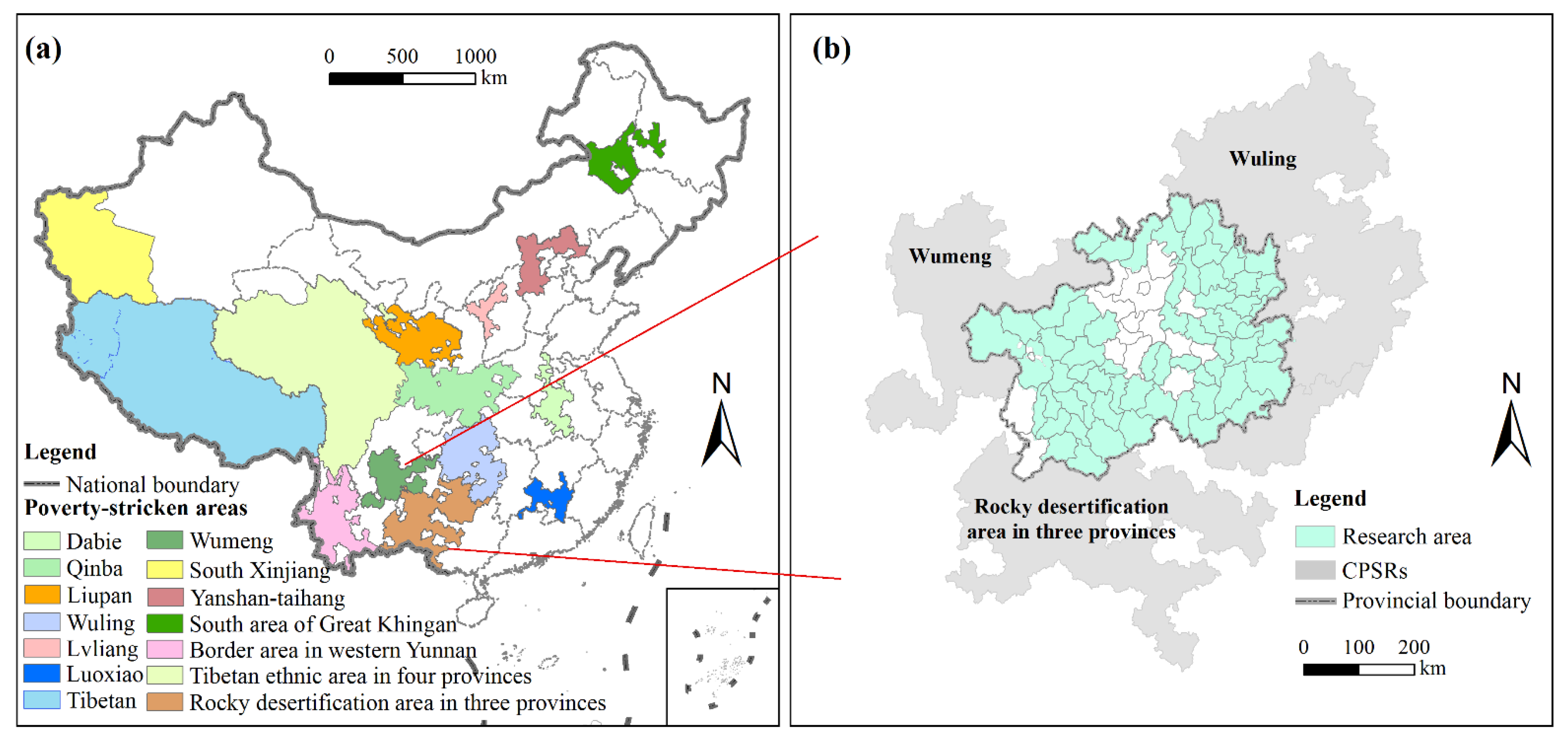
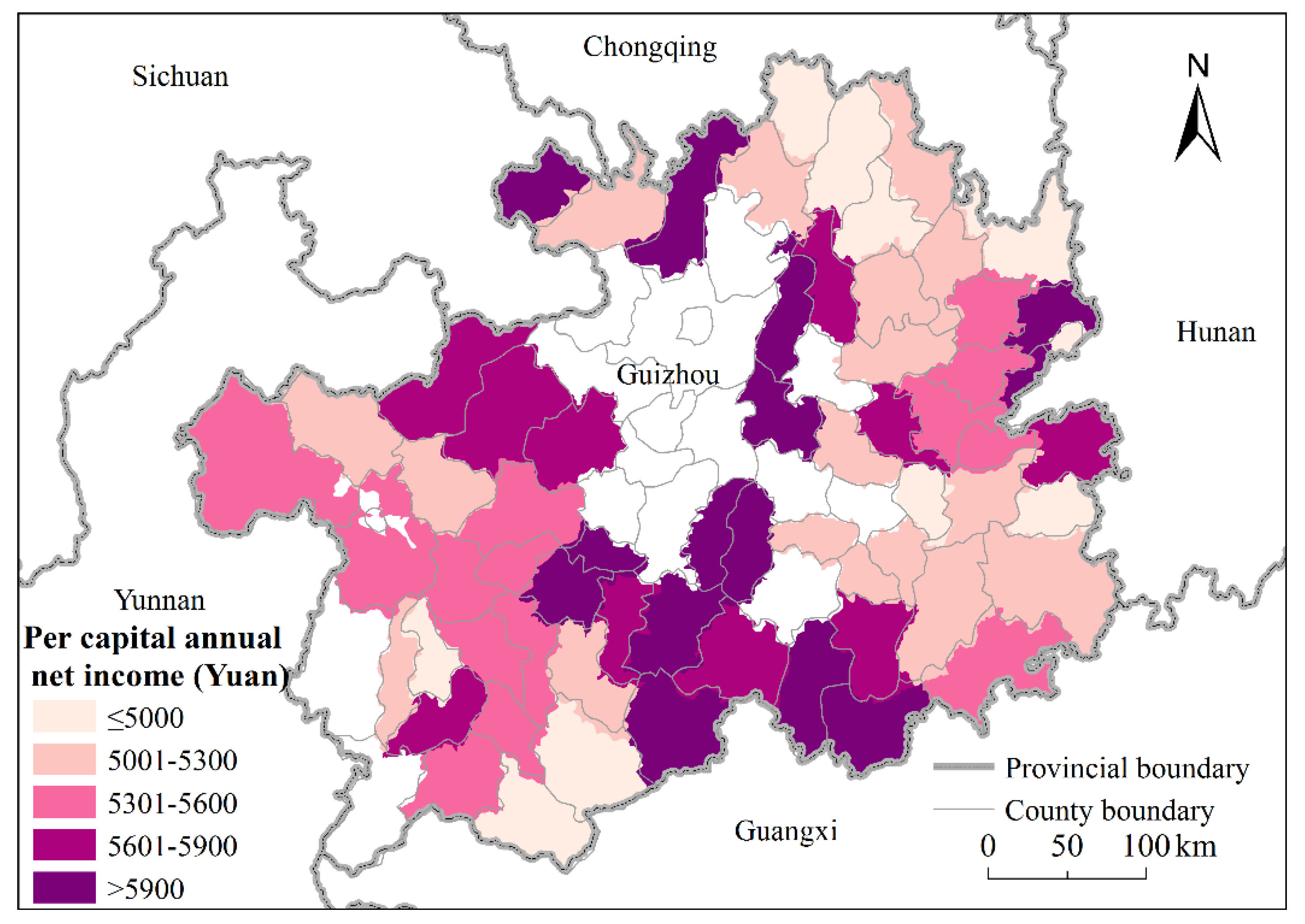
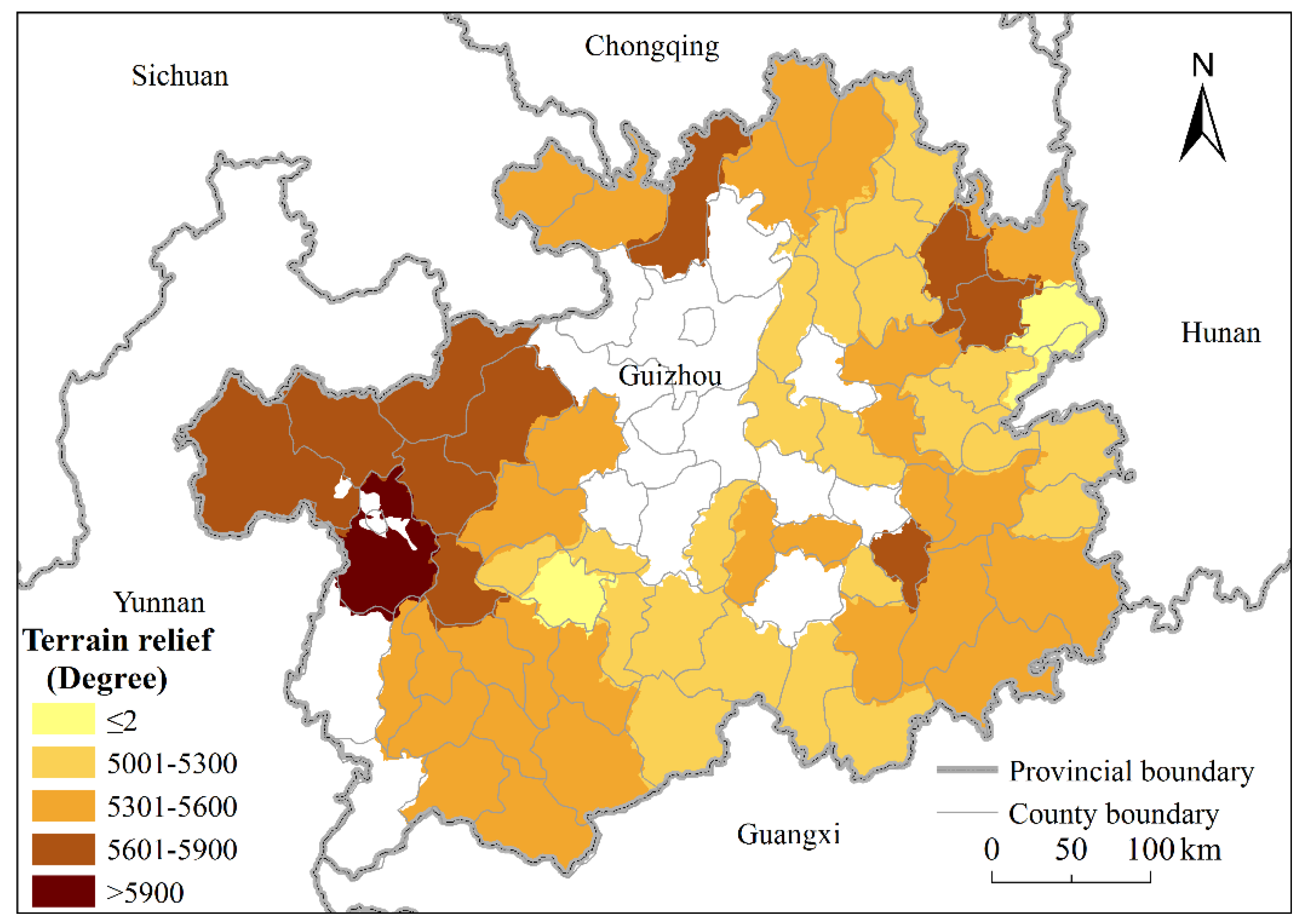
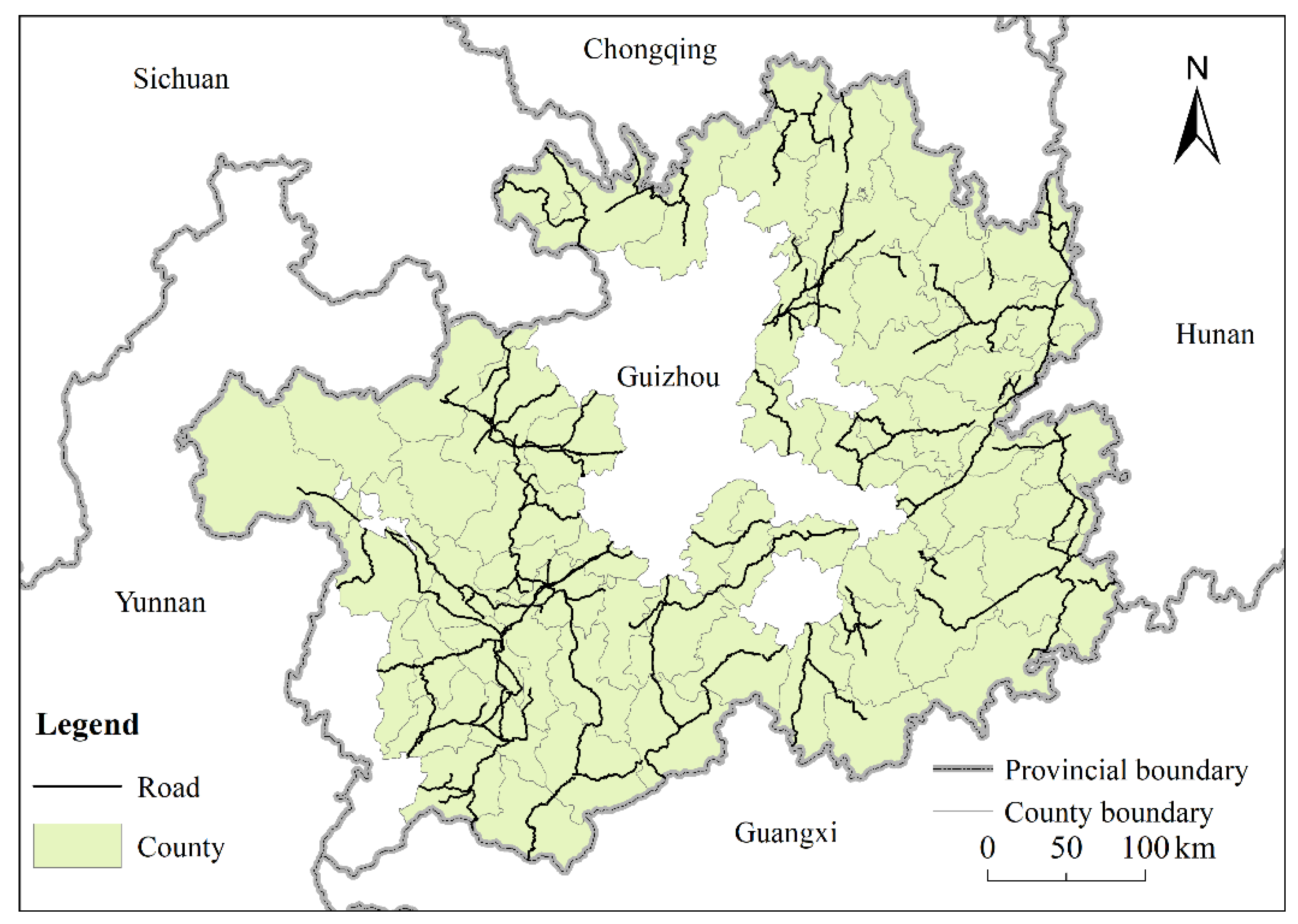

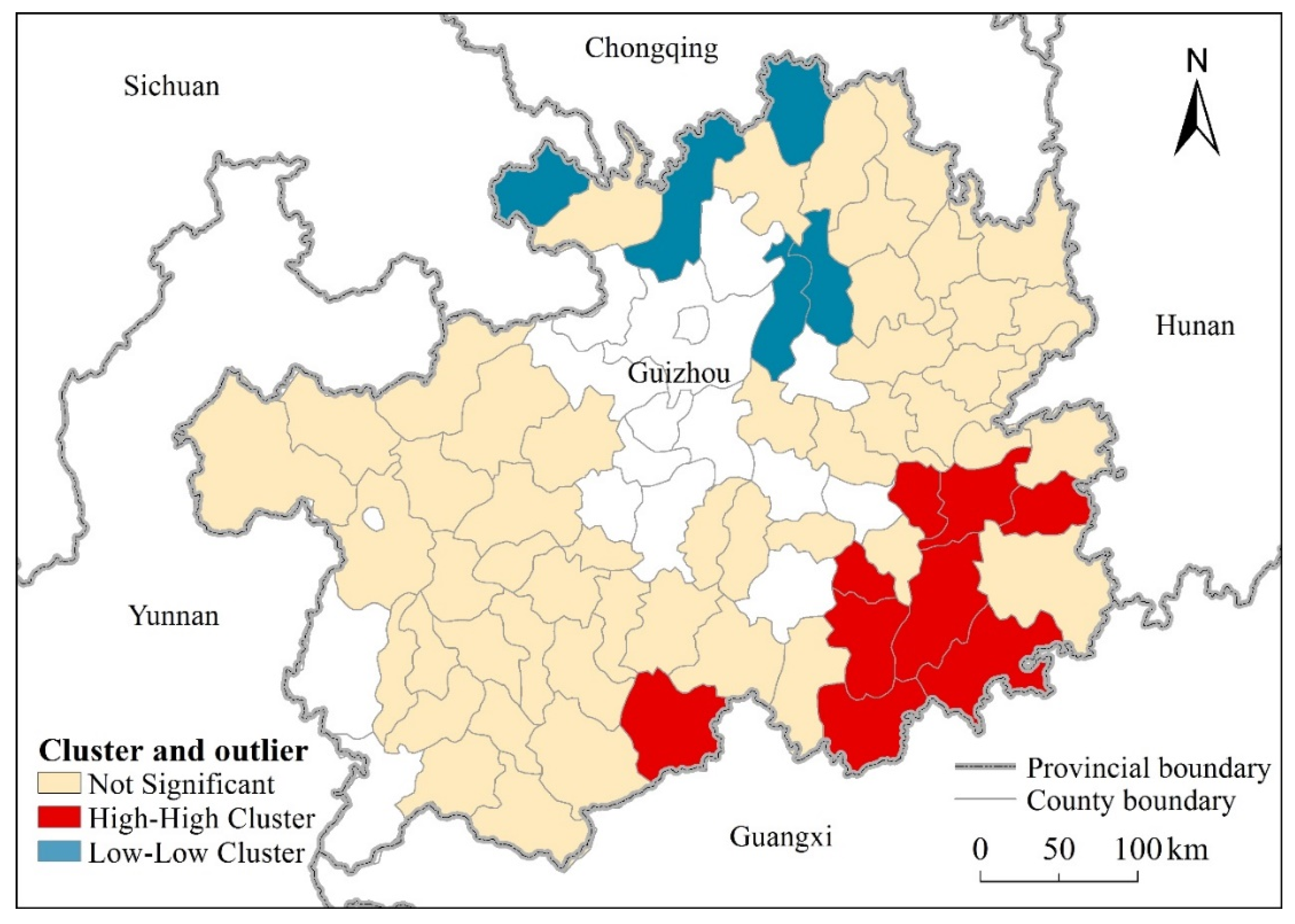
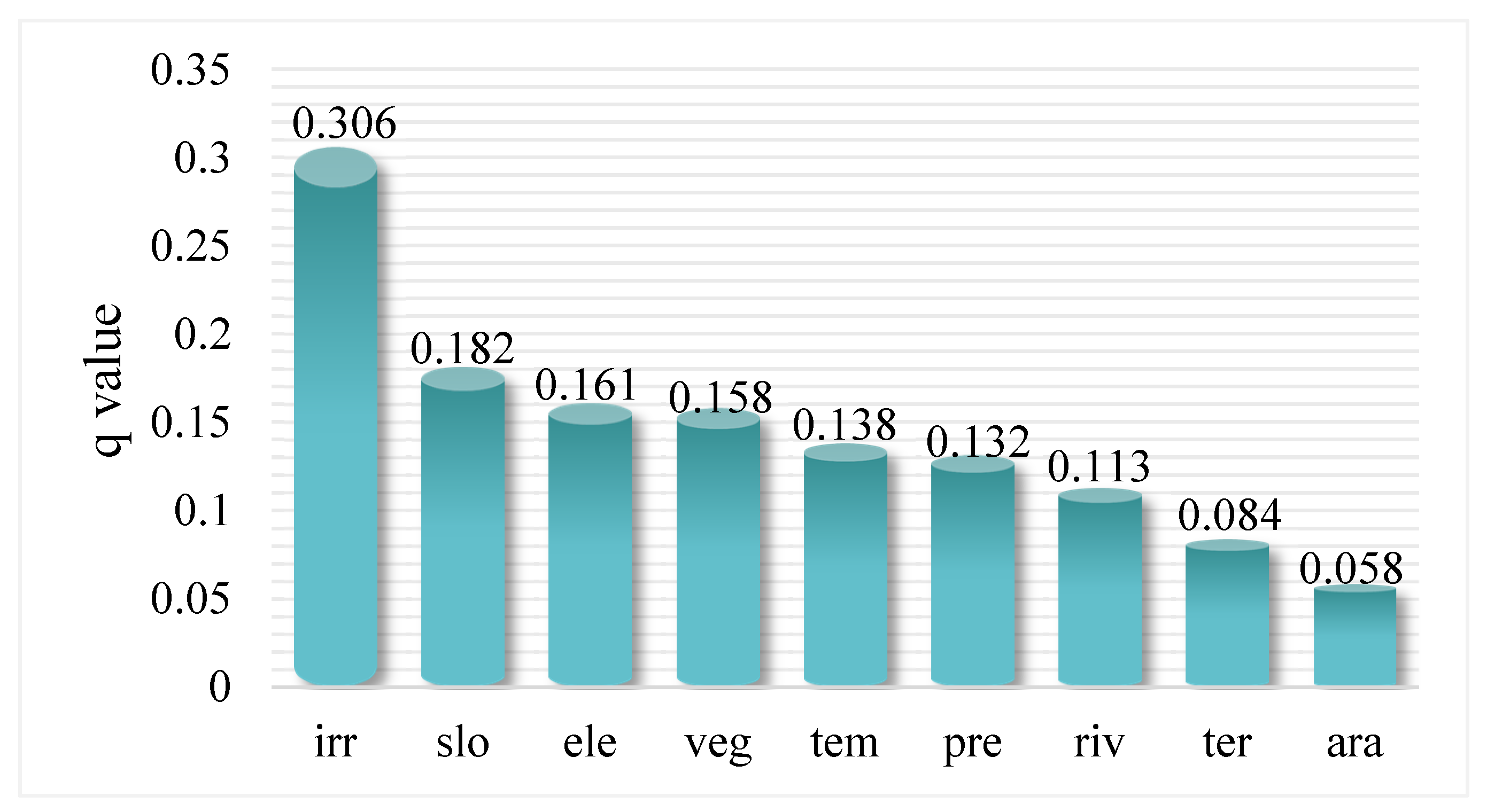
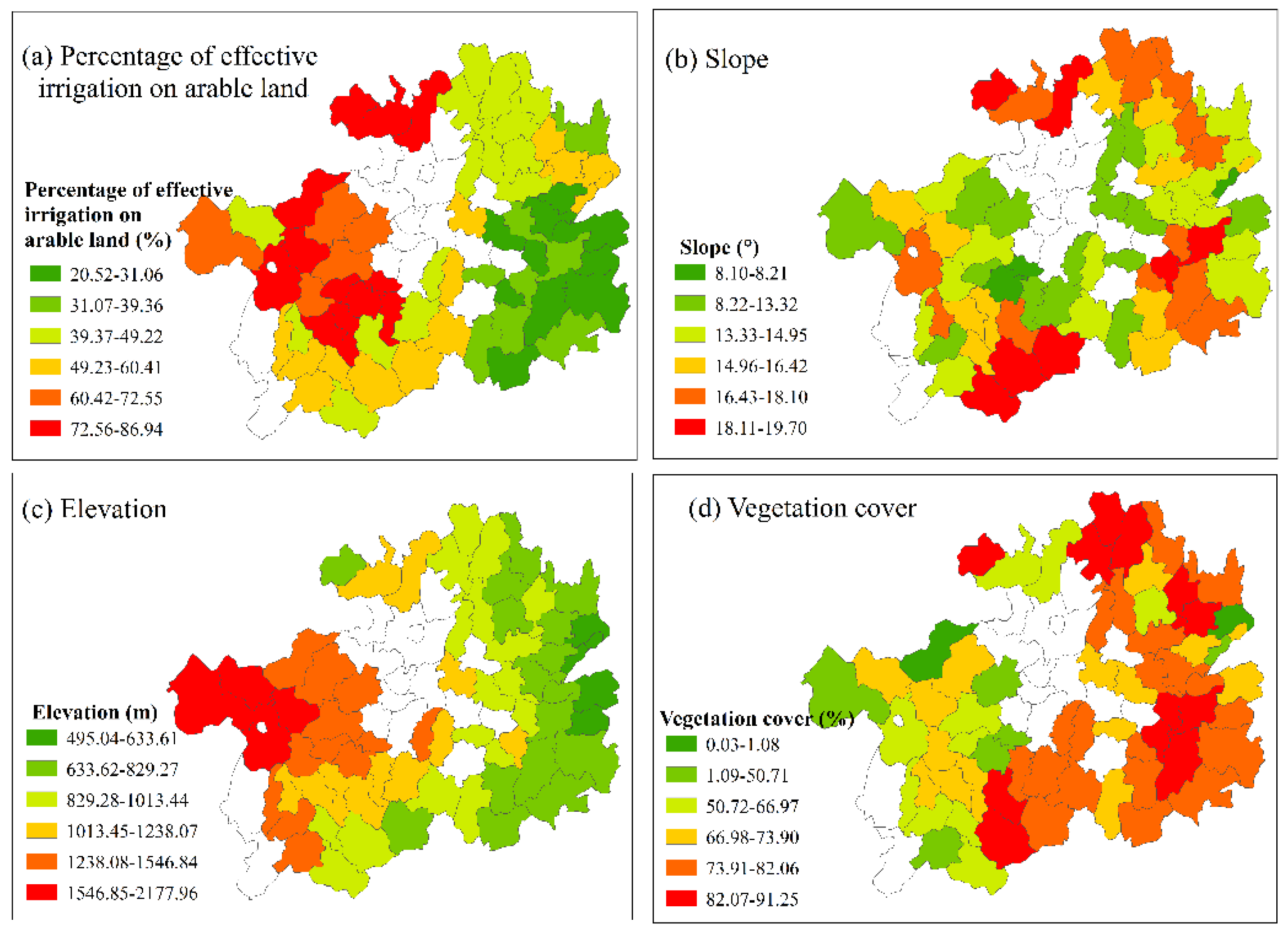
| Topography | Climate | Water Resources | Land Use |
|---|---|---|---|
| Elevation | Annual average temperature | River density | Vegetation cover |
| Slope | Annual average precipitation | Per capita arable land area | |
| Terrain relief | Percentage of effective irrigation on arable land |
| Graphical Representation | Description | Interaction |
|---|---|---|
 | q(xa ∩ xb) < Min(q(xa), q(xb)) | Weaken, nonlinear |
 | Min(q(xa), q(xb)) < q(xa ∩ xb) < Max(q(xa), q(xb)) | Weaken, univaraite |
 | q(xa ∩ xb) > Max(q(xa), q(xb)) | Enhance, bivariate |
 | q(xa ∩ xb) = q(xa) + q(xb) | Independent |
 | q(xa ∩ xb) > q(xa) + q(xb) | Enhance, nonlinear |
 Min(q(xa), q(xb));
Min(q(xa), q(xb));  Max(q(xa), q(xb));
Max(q(xa), q(xb));  q(xa) + q(xb);
q(xa) + q(xb);  q(xa ∩ xb).
q(xa ∩ xb).| xa ∩ xb | q Value | Description | Interaction |
|---|---|---|---|
| slope ∩ irrigation | 0.77 | q(slope ∩ irrigation) > q(slope) + q(irrigation) | Enhance, nonlinear |
| slope ∩ vegetation | 0.44 | q(slope ∩ vegetation) > q(slope) + q(vegetation) | Enhance, nonlinear |
| irrigation ∩ vegetation | 0.62 | q(irrigation ∩ vegetation) > q(irrigation) + q(vegetation) | Enhance, nonlinear |
Publisher’s Note: MDPI stays neutral with regard to jurisdictional claims in published maps and institutional affiliations. |
© 2021 by the authors. Licensee MDPI, Basel, Switzerland. This article is an open access article distributed under the terms and conditions of the Creative Commons Attribution (CC BY) license (https://creativecommons.org/licenses/by/4.0/).
Share and Cite
Ge, Y.; Ren, Z.; Fu, Y. Understanding the Relationship between Dominant Geo-Environmental Factors and Rural Poverty in Guizhou, China. ISPRS Int. J. Geo-Inf. 2021, 10, 270. https://doi.org/10.3390/ijgi10050270
Ge Y, Ren Z, Fu Y. Understanding the Relationship between Dominant Geo-Environmental Factors and Rural Poverty in Guizhou, China. ISPRS International Journal of Geo-Information. 2021; 10(5):270. https://doi.org/10.3390/ijgi10050270
Chicago/Turabian StyleGe, Yong, Zhoupeng Ren, and Yangyang Fu. 2021. "Understanding the Relationship between Dominant Geo-Environmental Factors and Rural Poverty in Guizhou, China" ISPRS International Journal of Geo-Information 10, no. 5: 270. https://doi.org/10.3390/ijgi10050270






